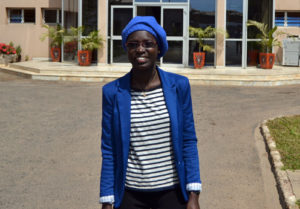The future food production in West Africa is challenged by climate change. Water availability might be threatened, which would have effect on agriculture, and therefore majority of the West African population.
There are concerns regarding water availability under different climate types and how we can cope with a degrading resource that is the primary production factor for irrigated agriculture in the coastal area of Senegal, the Niayes region.
“This raised our interest in knowing the optimal patterns of groundwater extraction for irrigation under climate uncertainty, and the potential gains from improved groundwater management”, says Amy Faye, a PhD student and a researcher at the Senegalese Institute of Agricultural Research (ISRA).
Resource management is required
 So far the results illustrate the value of improved groundwater management in the horticultural sector of Niayes. The results suggest that it is important to include resource management in the plans for adaptation of agriculture to climate change for the the Niayes region of Senegal.
So far the results illustrate the value of improved groundwater management in the horticultural sector of Niayes. The results suggest that it is important to include resource management in the plans for adaptation of agriculture to climate change for the the Niayes region of Senegal.
“After my master’s degree in industrial organization at the Toulouse School of Economics , in France, I went back to my country and had the opportunity to work as an intern at ISRA. The internship gave me the opportunity to work on wide range of subjects concerning the development of Senegal’s agricultural sector. I discovered agricultural economics and developed a strong awareness of the importance of agriculture in the economy of African countries. In Senegal more than 90 percent of farmers are small holder farmers and at least 60 percent of the population is employed by the agricultural sector. This motivated me to work as an economist on agricultural sector development concerns. I strongly believe that research can provide a strong basis for agricultural sector development and want to participate in that sector’s expansion”, she says.
After the internship, Amy had an opportunity to join the Bureau d’analyses macro-économiques (BAME) team at ISRA as a research fellow. She registered as a doctoral student at the Faculty of economics of the University of Dakar and started her PhD research focusing on horticultural crops in the Niayes area of Senegal. Soon after that Amy participated in a meeting with Siwa Msangi, leader of FoodAfrica work package 3 from the International Food Policy Research Institute. Siwa’s presentation on the FoodAfrica programme interested her and she had the opportunity to join the FoodAfrica team involved in the FoodAfrica at ISRA-BAME. Learning about the FoodAfrica programme guided Amy’s doctoral research to focus on climate change and horticultural crops. Her goal is to finish studies by the end of this year.
“My main contribution to FoodAfrica is through modeling agricultural production and climate change impact assessment in different agroecological regions of Senegal under the supervision of senior researcher Siwa Msangi”, Amy says.
“I have been participating in the assessment of climate change impact on farmers’ net returns by integrating endogenously developed strategies. We have been using different complementary tools: a population level model, the Tradeoff Analysis Model for Multi-Dimensional Impact Assessment and a farm level model based on positive mathematical programming methods.”
Amy further works on her PhD topic related to climate change impact on irrigated agriculture in the northern coastal area of Senegal. She points out several reasons for this choice. First, previous climate related research has mostly focused on rainfed crops in Senegal. Indeed, irrigated agriculture particularly horticultural crops mostly grown in the northern coastal region called Niayes have drawn less attention in terms of climate change or variability studies. Studies that involve climate aspects have mainly been done by hydrologists and geographers. Second, in the northern coastal region, at least 40 percent of Senegalese horticultural products are produced and farmers mainly grow irrigated crops during the dry season from October to June and use groundwater resources almost exclusively for their irrigation needs. Third, research has shown that climate variability combined with user behavior may threaten water availability for irrigation and other sectors, such as for industry, the Senegalese water company, municipalities, and rural populations. Moreover, in the Niayes, research has pointed out the growing levels of overdraft in the groundwater basin – i.e. when the aquifer depth decreases due to withdrawals exceeding the levels of rainfed-recharge into the basin.
Text: Amy Faye, ISRA & Jarkko Niemi, Luke
